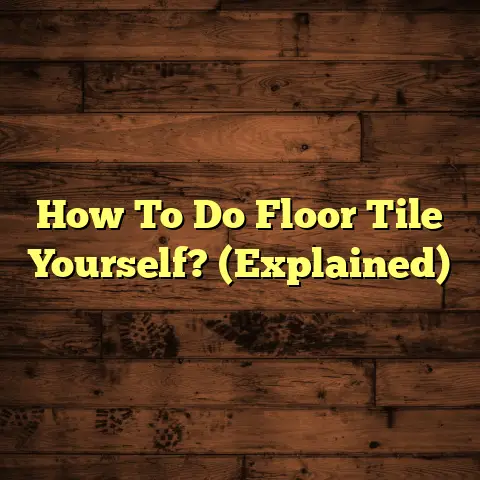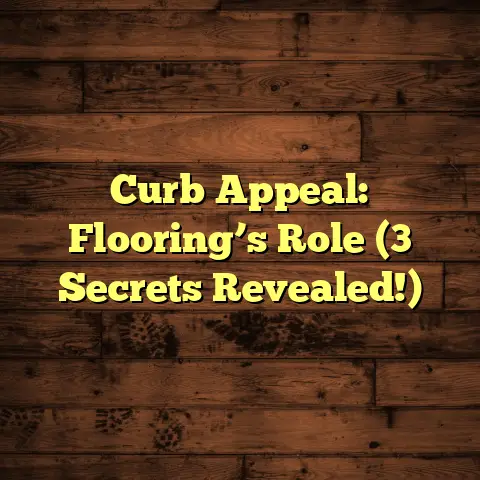Hybrid Flooring: What To Know? (7 Day Install Guide)
I’m here to talk about something that’s been making waves in the home improvement scene: hybrid flooring.
It’s popping up everywhere, and for good reason.
It’s accessible, durable, and looks fantastic.
Think of it as the lovechild of laminate and vinyl, taking the best qualities from both and leaving the drawbacks behind.
Families love it, seniors find it easy to maintain, and even if you’re a DIY newbie, you can get your hands dirty with it.
But before you dive headfirst into a hybrid flooring project, let’s break down what you really need to know.
We’ll cover everything from what it is to how to install it yourself in just 7 days.
Ready? Let’s get started!
1. Understanding Hybrid Flooring
1.1 What Is Hybrid Flooring, Anyway?
Alright, so what exactly is this “hybrid” stuff?
Simply put, it’s a multi-layered flooring option engineered for both durability and aesthetic appeal.
The core is usually made of stone plastic composite (SPC) or wood plastic composite (WPC).
SPC is denser and more rigid, while WPC is lighter and offers a bit more cushioning.
Then you’ve got a decorative layer with a high-definition image that mimics wood, stone, or tile.
Finally, a wear layer protects the surface from scratches, dents, and everyday wear and tear.
I’ve found that a thicker wear layer (think 20mil or higher) is worth the investment, especially in high-traffic areas.
1.2 Hybrid vs. The Old Guard:
Why Choose Hybrid?
Why go hybrid when you’ve got tried-and-true options like hardwood, laminate, and vinyl?
Well, let’s break it down:
-
Hardwood: Gorgeous, no doubt, but
it’s pricey, susceptible to moisture, and
requires specialized installation.I’ve seen too many beautiful hardwood
floors ruined by a leaky pipe. -
Laminate: Budget-friendly and
easy to install, but it can feel a bit
“hollow” underfoot and isn’t as water-resistant. -
Vinyl: Waterproof and comfortable,
but some cheaper vinyl options can look
a bit… well, cheap.
Hybrid bridges the gap.
It’s more water-resistant than laminate and hardwood, more durable than standard vinyl, and often more affordable than solid hardwood.
Plus, that rigid core makes it more forgiving on slightly uneven subfloors.
1.3 Style It Up: Designs, Textures, and Finishes
One of the things I love about hybrid flooring is the sheer variety of styles available.
You can find options that mimic everything from rustic reclaimed wood to sleek, modern concrete.
The textures are getting incredibly realistic, too.
Embossed-in-register (EIR) technology aligns the texture with the printed image, making it feel like real wood grain underfoot.
-
Smooth Finishes: Ideal for a clean,
contemporary look. -
Textured Finishes: Add depth and
character, perfect for rustic or traditional styles. -
Matte Finishes: Hide scratches and
wear better than high-gloss options.
Don’t be afraid to order samples and see how they look in your space with your lighting.
1.4 Going Green: Environmental Considerations
Sustainability is a big deal these days, and thankfully, there are eco-friendly hybrid flooring options out there.
Look for certifications like FloorScore, which indicates low VOC emissions.
Some manufacturers also use recycled materials in the core of their flooring.
Table: Common Eco-Friendly Hybrid Flooring Features
| Feature | Description |
|---|---|
| Low VOC Emissions | Certified to release minimal volatile organic compounds into the air. |
| Recycled Content | Made with recycled materials, reducing landfill waste. |
| Sustainable Sourcing | Wood or other materials sourced from responsibly managed forests. |
I always recommend asking about the environmental impact of the flooring you’re considering.
2. Preparing for Installation
2.1 Tool Time: What You’ll Need
Okay, let’s talk tools. Here’s a list of essentials for a successful hybrid flooring installation:
-
Measuring Tape: Accurate measurements are key.
-
Pencil: For marking cuts.
-
Utility Knife: For scoring and snapping planks.
-
Tapping Block and Hammer: To gently lock planks together.
-
Spacers: To maintain expansion gaps.
-
Circular Saw or Miter Saw: For more complex cuts.
-
Level: To check the subfloor.
-
Moisture Meter: To test the subfloor moisture level.
-
Broom or Vacuum: For cleaning the subfloor.
-
Safety Glasses and Gloves: Safety first!
I also recommend knee pads – your knees will thank you later.
2.2 Measure Twice, Cut Once:
Accurate Measurements
Before you even think about opening a box of flooring, measure your room carefully.
Draw a sketch and note the dimensions of each wall.
Don’t assume that walls are perfectly square – they rarely are.
Measure the length and width at multiple points to account for any irregularities.
Add 5-10% to your total square footage to account for waste from cuts and mistakes.
It’s better to have a little extra than to come up short halfway through the project.
2.3 Subfloor Prep: The Foundation
for Success
Your subfloor is the foundation for your new flooring, so it needs to be clean, level, and dry.
-
Cleaning: Sweep or vacuum thoroughly
to remove any dust, debris, or old adhesive. -
Leveling: Use a self-leveling compound
to fill in any dips or uneven spots.
I’ve used [Brand Name] with great success. -
Moisture Testing: Use a moisture meter
to check the moisture content of the
subfloor.Ideally, it should be below [Percentage]%
for concrete and [Percentage]% for wood.
If the moisture level is too high, you’ll need to address the source of the moisture before installing your flooring.
2.4 Choosing the Right Hybrid:
Know Your Space
Not all hybrid flooring is created equal.
Consider the specific needs of your space when choosing a product.
-
Moisture-Prone Areas (Bathrooms,
Kitchens): Look for 100% waterproof options. -
High-Traffic Areas (Hallways, Living
Rooms): Choose a product with a thicker
wear layer. -
Areas with Direct Sunlight: Opt for
flooring with UV protection to prevent fading.
Also, think about the overall aesthetic you’re going for.
Do you want a warm, rustic look or a sleek, modern vibe?
3. The 7-Day Installation Guide
Alright, here’s the moment you’ve been waiting for: the 7-day installation guide.
Remember, this is a general guideline, and your specific project may require some adjustments.
3.1 Day 1: Acclimation
Why Acclimation Matters:
Hybrid flooring needs to adjust to the temperature and humidity of your home before installation.
How to Acclimate:
-
Bring the unopened boxes of flooring
into the room where they will be installed. -
Lay the boxes flat, allowing air to circulate
around them. -
Maintain a consistent room temperature
(ideally between [Temperature Range]
degrees Fahrenheit) and humidity level
(between [Humidity Range]%) for at
least 48-72 hours.
I know it’s tempting to skip this step, but trust me, it’s worth the wait.
3.2 Day 2: Preparing the Subfloor
Subfloor Prep Checklist:
-
Clean: Sweep or vacuum the subfloor
thoroughly. -
Level: Use a self-leveling compound
to fill in any dips or uneven spots. -
Underlayment (Optional): If your
hybrid flooring doesn’t have a pre-attached
underlayment, consider adding one for
extra cushioning and sound insulation.
Why a Smooth Subfloor is Crucial:
An uneven subfloor can cause the flooring to flex and creak, and it can even damage the locking system.
Take the time to do this step right.
3.3 Day 3: Planning the Layout
Layout Considerations:
-
Direction of Planks: Generally, running
planks parallel to the longest wall of the
room makes the space look larger. -
Staggering Seams: Stagger the seams
between rows to create a more natural
look and add strength to the floor.I usually aim for a minimum of 6 inches
between seams. -
Expansion Gaps: Leave a 1/4-inch
expansion gap around the perimeter of
the room and around any fixed objects
like pipes or doorframes.This allows the flooring to expand and
contract without buckling.
Visual Appeal Tips:
-
Avoid placing very short pieces at the
end of rows. Try to plan your layout so
that the end pieces are at least half the
length of a full plank. -
Mix planks from different boxes to create
a more varied and natural look.
3.4 Day 4: Starting the Installation
Getting Started:
-
Choose a Starting Point: I usually
start in a corner of the room, with the
tongue side of the plank facing the wall. -
Cut the First Row: You may need to
cut the first row of planks to fit the
width of the room, taking into account
the expansion gap. -
Install the First Row: Place the planks
along the wall, using spacers to maintain
the expansion gap.
Maintaining Straight Lines:
Use a chalk line or a straight edge to ensure that your first row is perfectly straight.
This will set the foundation for the rest of the installation.
3.5 Day 5: Continuing the Installation
Laying Subsequent Rows:
-
Lock the Planks Together: Angle the
tongue of the new plank into the groove
of the existing plank and gently tap it
into place using a tapping block and hammer. -
Stagger Seams: Remember to stagger
the seams between rows. -
Use Spacers: Continue using spacers
along the walls to maintain the expansion gap.
Durability Tips:
-
Make sure the planks are fully engaged
and locked together. -
Avoid using excessive force when tapping
the planks together.
3.6 Day 6: Completing the Installation
Finishing Touches:
-
Cutting Planks for the Last Rows:
You’ll likely need to cut the planks in
the last rows to fit the width of the room. -
Installing Thresholds and Transition
Strips: Install thresholds in doorways
and transition strips where the flooring
meets other types of flooring. -
Cleaning the Floor: Sweep or vacuum
the floor to remove any debris or dust.
Guidance on Final Cuts:
Use a jigsaw or a utility knife to make precise cuts around doorframes and other obstacles.
3.7 Day 7: Post-Installation Care and Maintenance
Letting the Floor Settle:
Avoid heavy traffic on the floor for at least 24 hours after installation.
Cleaning and Care Tips:
-
Sweep or vacuum regularly to remove
dirt and debris. -
Use a damp mop with a mild detergent
to clean the floor. -
Avoid using abrasive cleaners or harsh
chemicals. -
Place mats at entrances to trap dirt and
moisture. -
Use furniture pads under heavy furniture
to prevent scratches.
Long-Term Maintenance:
With proper care, your hybrid flooring should last for many years.
Conclusion
So, there you have it: a comprehensive guide to hybrid flooring.
It’s durable, stylish, and relatively easy to install.
Whether you’re a seasoned DIYer or a complete newbie, hybrid flooring is a viable option for your home improvement projects.
Remember to take your time, follow the instructions carefully, and don’t be afraid to ask for help if you need it.
Happy flooring!





